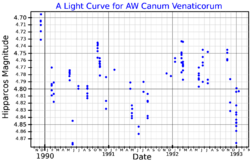AW Canum Venaticorum
Topic: Astronomy
 From HandWiki - Reading time: 3 min
From HandWiki - Reading time: 3 min
| Observation data Equinox J2000.0]] (ICRS) | |
|---|---|
| Constellation | Canes Venatici |
| Right ascension | 13h 51m 47.47504s[2] |
| Declination | +34° 26′ 39.2474″[2] |
| Apparent magnitude (V) | 4.76[3] (4.73 – 4.85)[4] |
| Characteristics | |
| Spectral type | M3- IIIa[5] |
| B−V color index | 1.611±0.006[3] |
| Variable type | Lb[4] |
| Astrometry | |
| Radial velocity (Rv) | −44.21±0.25[3] km/s |
| Proper motion (μ) | RA: −20.477[2] mas/yr Dec.: −31.626[2] mas/yr |
| Parallax (π) | 5.2734 ± 0.2529[2] mas |
| Distance | 620 ± 30 ly (190 ± 9 pc) |
| Absolute magnitude (MV) | −1.56[3] |
| Details | |
| Mass | 2.18±0.16[6] M☉ |
| Radius | 117.41+4.25 −4.57[6] R☉ |
| Luminosity | 2,387±213[6] L☉ |
| Surface gravity (log g) | 0.98±0.30[7] cgs |
| Temperature | 3,529±25[7] K |
| Metallicity [Fe/H] | −0.09±0.11[7] dex |
| Age | 1.11±0.21[6] Gyr |
| Other designations | |
| Database references | |
| SIMBAD | data |
AW Canum Venaticorum is a variable star[4] in the constellation Canes Venatici. It is visible to the naked eye with a nominal apparent visual magnitude of 4.76.[3] The distance to this star, as measured from its annual parallax shift of 5.3 mas,[2] is around 620 light years. It is moving closer with a heliocentric radial velocity of −44 km/s.[3]
At the age of 1.1 billion years,[6] this is an evolved red giant star with a stellar classification of M3- IIIa.[5] It is a slow irregular variable of type Lb, with a brightness that ranges between magnitudes 4.73 and 4.85.[4] The star has 2.2[6] times the mass of the Sun and has expanded to 117[6] times the Sun's radius. It is radiating 2,387[6] times the Sun's luminosity from its enlarged photosphere at an effective temperature of 3,529 K.[7]
References
- ↑ "Hipparcos Tools Interactive Data Access". ESA. https://www.cosmos.esa.int/web/hipparcos/interactive-data-access.
- ↑ 2.0 2.1 2.2 2.3 2.4 2.5 Brown, A. G. A. (August 2018). "Gaia Data Release 2: Summary of the contents and survey properties". Astronomy & Astrophysics 616: A1. doi:10.1051/0004-6361/201833051. Bibcode: 2018A&A...616A...1G.
- ↑ 3.0 3.1 3.2 3.3 3.4 3.5 Anderson, E.; Francis, Ch. (2012), "XHIP: An extended hipparcos compilation", Astronomy Letters 38 (5): 331, doi:10.1134/S1063773712050015, Bibcode: 2012AstL...38..331A.
- ↑ 4.0 4.1 4.2 4.3 Samus', N. N; Kazarovets, E. V; Durlevich, O. V; Kireeva, N. N; Pastukhova, E. N (2017), "General catalogue of variable stars: Version GCVS 5.1", Astronomy Reports 61 (1): 80–88, doi:10.1134/S1063772917010085, Bibcode: 2017ARep...61...80S.
- ↑ 5.0 5.1 Keenan, Philip C.; McNeil, Raymond C. (1989), "The Perkins catalog of revised MK types for the cooler stars", Astrophysical Journal Supplement Series 71: 245, doi:10.1086/191373, Bibcode: 1989ApJS...71..245K.
- ↑ 6.0 6.1 6.2 6.3 6.4 6.5 6.6 6.7 Baines, Ellyn K. et al. (2018), "Fundamental Parameters of 87 Stars from the Navy Precision Optical Interferometer", The Astronomical Journal 155 (1): 30, doi:10.3847/1538-3881/aa9d8b, Bibcode: 2018AJ....155...30B.
- ↑ 7.0 7.1 7.2 7.3 Prugniel, P. et al. (2011), "The atmospheric parameters and spectral interpolator for the MILES stars", Astronomy & Astrophysics 531: A165, doi:10.1051/0004-6361/201116769, Bibcode: 2011A&A...531A.165P.
- ↑ "HD 120933". SIMBAD. Centre de données astronomiques de Strasbourg. http://simbad.u-strasbg.fr/simbad/sim-basic?Ident=HD+120933.
 |
10 views | Status: cached on August 22 2024 20:35:43
↧ Download this article as ZWI file
 KSF
KSF
